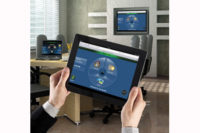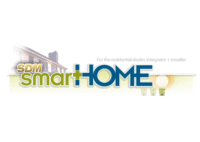From holiday cookouts to relaxing by the pool, summertime means more time outdoors. As homeowners step outside and want to bring technology with them, new opportunities arise for integrators willing to take them there.
“We love to be outside. We love our music and video. So why not access it with the mobile devices we are always walking around with in our hands? It’s a natural kind of extension,” says Dave Pedigo, senior director of learning and emerging technology for the Custom Electronic Design and Installation Association (CEDIA), Indianapolis, Ind.
Growing demand for outdoor technology extends well beyond seasonal activities. Mike Yslas, regional manager of Las Vegas-based Global Outdoor Concepts, attributes the increasing consumer interest to the “cocooning effect.”
“People aren’t traveling as much, so they’re spending money in their own home.”
Heavy investment in advertising by the big corporations has increased customer awareness of the possibilities in home technology, says Helen Heneveld, president of Bedrock Learning in Holland, Mich., a provider of online training in residential technology. The entrance into the marketplace of the generation that has grown up with technology has also contributed to the growing demand, she says.
Indeed, as consumers have become more comfortable with technology, they see it as something they can’t do without. “If you’re a tech savvy person, this is something you expect. In their minds, it’s a need,” says Jill Lloyd, president of Lloyd Security, a Minneapolis, Minn.-based Alarm.com dealer.
Advances in outdoor technology are providing more solutions to meet the demand. “The technology is simpler, more reliable and cost-effective,” Heneveld says.
As with other areas of home automation and security, remote access through mobile devices has played a substantial role. Improved range and functionality, along with weatherproofing, of wireless sensors and devices have made it easier and more cost-effective to install outdoor than before.
“The new wireless devices are getting phenomenal range. Over the past several years, the adoption rate of wireless security devices has grown significantly,” says Kevin Piel, senior marketing manager for Melville, N.Y.-based Honeywell Security.
The combination of improved technology and increased consumer interest has created four areas of opportunity for dealers and integrators to expand into the outdoor space “It’s kind of nice. We’re stepping outside the traditional security space and giving homeowners options,” Piel shares.
Garage Doors
One of the biggest developments in recent months has been the integration of garage doors with security panels.
Integrating garage doors as a protected part of the security system fills a long-standing gap in home security and offers homeowners new level of convenience.
“The perspective of what the system can do has changed with this technology,” explains Paul Romanelli, president of Suffolk Security, a Honeywell dealer based in Southold, N.Y.
A number of companies have recently introduced features that send status alerts and enable remote opening and closing of garage doors. Lloyd says Alarm.com’s garage door option is in the greatest demand from her customers. “We had a waiting list for that feature to become available,” she adds.
Securing Outdoor Assets
Wireless technology is making it easier to secure sheds, gates, pools, and air conditioners or other outdoor equipment. “From a security standpoint, sheds and detached garages are a natural progression. “That’s the easiest and most cost-effective extension of security,” Piel says. As empty nesters with disposable income explore new hobbies, they want to protect their snowmobiles, jet skis, ATVs, and other equipment.
“They’re taking their dollars outside the home. They want to protect that investment and control that investment,” says Kirk MacDowell, vice president, intrusion sales, Americas, for Bradenton, Fla.-based Interlogix. In June, Interlogix released its new, dual-technology D1601 outdoor motion sensor, designed to operate at extreme temperatures and to be easier and faster to install than its hardwired counterpart.
Honeywell’s 5816OD outdoor, weatherproof, water-resistant, wireless transmitter can be used for gates, sheds, detached garages, or outdoor equipment.
Combining these devices with cameras and remote services, security systems can be configured to send photos or video clips when sensors are triggered, giving homeowners a new level of awareness and control of their property. “That’s really an amazing, incredible advantage. Being able to have that kind of integration makes a big difference,” Romanelli says.
Outdoor Audio
Consumers are investing in outdoor entertainment as well as security. “People want to have music in more places, and it’s becoming easier to do that,” says Josh Christian, marketing vice president of CEDIA member DSI Entertainment Systems, located in Los Angeles. He adds that 10 years ago it was uncommon to install sound systems outside, but now “we see outdoor audio becoming more of a standard feature in our installations.”
Instead installing of two large speakers, as has been standard practice, integrators are now using multiple, small, satellite speakers. These smaller speakers can be easily hidden throughout the greenscape and yield more even sound coverage. “Sound is coming from everywhere and nowhere at the same time. It’s one of those jaw-dropping experiences,” Christian describes, adding that over 80 percent of people who hear it end up purchasing it.
Outdoor Television
Weatherproof enclosures, optical coatings, software enhancements and other new technologies have dramatically improved the outdoor television viewing experience.
“We’re seeing a big increase in people paying extra for TVs made especially for outdoors,” Christian says.
Automated lift systems and inflatable or retractable projection screens are providing for additional flexibility in outdoor entertainment. New technology to enhance picture brightness is making outdoor video options more attractive for homeowners. Global Outdoor Concepts’ Mega Picture Enhancement Technology (MPET) calibration system brightens the picture and enhances color, sharpness and contrast, creating better picture quality even in 3D and direct sunlight, explains Yslas, whose company modifies televisions for outdoor use.
Global Outdoor Concepts is currently working on a new portable device for dealers that can be used to download MPET information onto any TV to enhance picture quality, Yslas reports. Dealers will be able to bring the device to the client’s home and download the picture enhancement technology to any television. “It’s so self-explanatory that somebody who has no experience with television can install it. They can make a great living off this thing,” Yslas says of the MPET device, which is scheduled to be released at the CEDIA Expo in September.
High-definition video technology developed for the outdoors can be used to enhance video surveillance too. “Security companies are using high-end, detailed televisions for playback monitors. If you don’t have high-end TV, you can’t get all the detail of high-quality cameras,” Yslas says.
Opening the Door to Opportunity
Even though the outdoor options are available, when it comes to security and home entertainment, most homeowners don’t think outside the house. “While designing the system, it’s important for salespeople to walk outside and ask the customer what’s important outside,” MacDowell suggests.
Dealers who educate their clients about outdoor products and features can create revenue opportunities and increase sales.
“Dealers who ask the right questions will get the most opportunities,” Piel says.
Most integrators will find it relatively easy to move into the outdoor market, as their existing skill sets transfer well. Exploring outdoor options provides integrators with new ways to expand their businesses while enhancing the customers’ sense of security and enjoyment of the system.
MacDowell says, “When you tie it all together, you take users from inside to outside the home and extend the footprint of security and lifestyle features and capabilities.”
Installation Concerns
As with indoor systems, the performance of outdoor security and entertainment systems rely on the quality of installation. “It’s a lot of little things that make a difference between a good installation and a great installation,” says CEDIA’s Dave Pedigo.
Equipment
Although it may be tempting to use devices designed for indoor use, only equipment designed specifically to withstand the effects of sunlight, water, and wind should be used for outdoor installations to ensure safety, long life, and better performance.
Sunlight
Enhanced software and screen technology have improved picture quality in outdoor light. Select televisions and other video equipment designed for use in bright light. Even with improved technology, direct sunlight is not conducive to the best viewing experience. Avoid installing outdoor screens facing directly east or west.
Mounting
Mounting electronic equipment outdoors requires additional consideration of factors such as aesthetics, convenience, and the availability of suitable mounting surface. Outdoor equipment must be properly placed and securely mounted to withstand strong winds to prevent damage to the equipment and home.
Code
Installers must comply with state and local codes governing outdoor installations. Integrating the outdoor wiring with the wiring inside the home may involve special consideration in terms of regulations or materials.
Hardwiring
Wireless outdoor sensors, motion detectors, and IP cameras have made it possible to expand outdoor systems into new areas. However, depending on the installation specifications, sometimes hardwired equipment may be the better choice. Running wire outdoors involves different challenges for integrators to address.
Digging
Safety precautions must be taken when burying wire, including coordinating with local utilities to avoid hitting power or gas lines. Care must also be taken in determining how deep to bury the wire so that it will not be inadvertently damaged by homeowners or landscapers performing yard maintenance.
Type of Wire
Select the type of wire or cable appropriate for outdoor use and to meet local codes. Some wiring may need to be run with conduit. Flooded cable, wire with gel between the wire and outer jacket, is another option.
Grounding
Providing proper grounding for outside electrical systems is absolutely critical. Ground fault interrupters (GFIs) and surge protection should be used to protect all electronic devices and exterior wiring needs special care. “Really understand the grounding issues,” Pedigo cautions. In the event of a lightning strike, even an indirect one, lightning can dissipate and, if the installation is not properly grounded, exterior wiring could conduct the lightning into the home, he warns.
Turn Up the Power
Integrators moving into outdoor audio should consider learning how to work with 70-volt (a.k.a. constant voltage or high impedance) systems, recommends Scott Pisani, product manager, audio at Speco Technologies based in Amityville, N.Y. While most integrators of indoor audio systems are accustomed to working with 8-ohm, or low impedance, systems, 70V systems offer some benefits for outdoor installations. Because it allows integrators to run wires for greater distances (up to 500 feet) and to daisy chain multiple speakers, Pisani says that 70V wiring is increasingly being used for residential installations. Learning to work with 70V systems is not a difficult transition for integrators. “It’s nothing to be intimidated by,” says Pisani. “If you can get the basics of it, you can do most residential.”









